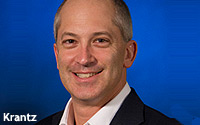CEO Krantz Explains YP's Digital Transition
- by Mark Walsh @markfwal, March 9, 2013

YP was formed nearly a year ago through the combination of AT&T Interactive (operating YP.com) and AT&T Advertising Solutions (the Yellow Pages directories).
Now majority-owned by Cerberus Capital Management, YP is one of the country’s largest local advertising companies. Roughly a third of its $3 billion in annual
revenue comes from the digital side, and about $300 million of that total comes from mobile.
Leading YP into the digital future is David Krantz, formerly president and CEO of AT&T
Interactive. In addition to YP.com and the 1,200 directories, he oversees the YP Local Ad Network, with 60 million monthly visitors, the YP app, and a sales force of nearly 4,000. Online Media Daily
caught up with Krantz last week at an industry conference in New York.
OMD: As YP’s digital side ramps up and the print side contracts, when will most revenue
begin to come from digital?
Krantz: If we package it right for an advertiser for an overall media campaign, then you don’t think of it as a print placement or
online display. So print becomes part of the mix. Revenue is going to cross over in the next three years, and traffic is going to cross over in the next three years, just based on consumer usage.
OMD: What are respective rates of growth and decline?
Krantz: We haven’t published the numbers, but the digital
business is growing and the print business is declining. And our goal is to make digital grow a lot faster. So with the new company, as one team, and the ability to marry channels with the digital
platform, we’re going to be able to accelerate growth.
OMD: Geographically, how is YP split between the directory business and digital?
Krantz: Historically we’ve been focused on 22 states with our print books. So we’re really starting to ramp up the other 28 states. In 22 states, we sell print and
Internet, and in 28 states we just sell digital. From a revenue perspective, we’re heavily skewed toward where we sell print because we sell as a package, and that’s where all the sales
resources were. So as part of the new company, we’re actively investing in more sales resources in the 28 other states.
OMD: How do you manage that
transition from print to digital around the country?
Krantz: As print goes away, what’ll happen is, market-by-market, it’s going to get shut off. You end
up with a national digital/mobile business, based on publishing assets consumers are using. It could be in a given market, like a suburb of New York, there’s not enough usage to keep printing
the books, so you shut it down. We’ve shut down a few books here and there, in Tampa and other areas. And then you just become all digital.
OMD: What about
YP’s activity on the mobile side?
Krantz: One of the interesting things is this mobile display network that we’ve built as an extension of our
existing ad network. You get [mobile ad placement] with a standard listing ad -- a search ad. We just created a new national team, we hired a senior guy out of AOL (David Lebow), and he’s going
to take some of the [assets] we have and package them for large national-targeting-local customers.
We just created a Dynamic Store Locator….so if you’re a retailer, we
can create an ad unit for you in 24 hours because we already know all your locations. And we can drop it in this mobile ad network of 1 billion+ impressions. We’ll be doing things like that with
national lead-gen type of products.
OMD: What’s your approach when it comes to working with small businesses?
Krantz: Where we’re going on the small/local side is that we want to simplify, and make it more about lead-based campaigns wrapped with performance management. We started
with our listing ads then we built search engine marketing, we sell Web sites, we sell video ads, we sell 360-degree views, so we have a broad portfolio of advertising -- almost too much. At the end
of the day, a small business just wants leads.


